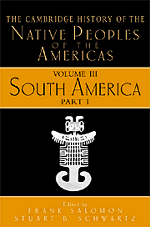Book contents
- Frontmatter
- Contents
- List of Illustrations
- Introduction
- 1 Testimonies: The Making and Reading of Native South American Historical Sources
- 2 Ethnography in South America: The First Two Hundred Years
- 3 The Earliest South American Lifeways
- 4 The Maritime, Highland, Forest Dynamic and the Origins of Complex Culture
- 5 The Evolution of Andean Diversity: Regional Formations (500 B.C.E.–C.E. 600)
- 6 Andean Urbanism and Statecraft (c.E. 550–1450)
- 7 Chiefdoms: The Prevalence and Persistence of “Señoríos Naturales” 1400 to European Conquest
- 8 Archaeology of the Caribbean Region
- 9 Prehistory of the Southern Cone
- 10 The Fourfold Domain: Inka Power and Its Social Foundations
- 11 The Crises and Transformations of Invaded Societies: The Caribbean (1492–1580)
- 12 The Crises and Transformations of Invaded Societies: Andean Area (1500–1580)
- 13 The Crises and Transformations of Invaded Societies: Coastal Brazil in the Sixteenth Century
- Index
1 - Testimonies: The Making and Reading of Native South American Historical Sources
Published online by Cambridge University Press: 28 March 2008
- Frontmatter
- Contents
- List of Illustrations
- Introduction
- 1 Testimonies: The Making and Reading of Native South American Historical Sources
- 2 Ethnography in South America: The First Two Hundred Years
- 3 The Earliest South American Lifeways
- 4 The Maritime, Highland, Forest Dynamic and the Origins of Complex Culture
- 5 The Evolution of Andean Diversity: Regional Formations (500 B.C.E.–C.E. 600)
- 6 Andean Urbanism and Statecraft (c.E. 550–1450)
- 7 Chiefdoms: The Prevalence and Persistence of “Señoríos Naturales” 1400 to European Conquest
- 8 Archaeology of the Caribbean Region
- 9 Prehistory of the Southern Cone
- 10 The Fourfold Domain: Inka Power and Its Social Foundations
- 11 The Crises and Transformations of Invaded Societies: The Caribbean (1492–1580)
- 12 The Crises and Transformations of Invaded Societies: Andean Area (1500–1580)
- 13 The Crises and Transformations of Invaded Societies: Coastal Brazil in the Sixteenth Century
- Index
Summary
This introductory chapter surveys writings that contain native South American versions of the past and problematizes the way they contain them. Its main purpose is to afford readers a “feel” for native sources’ diverse viewpoints, their verbal textures, their transformations during editing into non-native genres, and their historiographic promise. Secondarily, it raises questions about making a History out of materials that mobilize memory in ways more or less distant from Euro-American historiography. In what sense is a chant in praise of mummified ancestors or a Kogi origin story a historical source? What reading shall we give them? Aside from writing histories of South American Indians, a stillunderdeveloped but basically conventional part of the academic agenda, has anyone written South American Indian histories? What sorts of textual pasts are indigenous South American writers producing now? The first five parts sketch the literature of colonial native testimonies.
The next three sections concern modern sources in their relation to ethnography (see Map I.I). The final two sections concern methodological issues about oral tradition, literacy, and the material record. Overall, and especially from page 51 onward, the chapter is concerned with some critical questions that arise in the effort to imbue historiography with ethnographic insight: How different and how separate are mythic and historical “past-discourses”? Why has the West been slow to recognize South American social memory? What difference does the introduction of writing make to indigenous treatments of the past? Where local uses of the past differ fundamentally from literate historiography, how can historians handle them with authenticity?
RECORDING OF EVENTS AND MEMORIES IN NATIVE MNEMOTECHNOLOGIES
South America offers nothing similar to Mesoamerican codices because no native South American culture practiced writing in the common sense of the word before Iberian contact. To be sure, before 1492, most South Americans expressed thoughts about descent, time, and change in innumerable mnemonic practices, which, without resembling writing, were taken as legible remembrances. Some groups encoded the past in bodily actions: dances with costumes representing ancient beings, or chants, or pilgrimages to origin places. Others inscribed the past in sacred artifacts, some meant to eternalize evocative bodily action: lifelike ancestor mummies, trophies such as masks made from human faces (in Peru) or skins of enemies stuffed with ash (in Colombia) to commemorate victories. Other mnemonic objects aggrandized a historic person or kin group in tomb architecture, including (in Peru) palatial structures holding dead sovereigns.
- Type
- Chapter
- Information
- Publisher: Cambridge University PressPrint publication year: 1999
- 1
- Cited by



